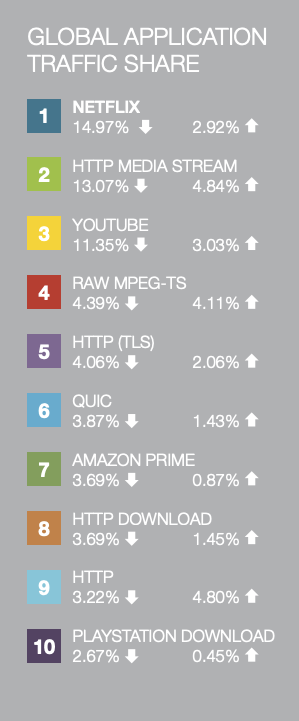Based on the data reported in the 2018 edition of the “Sandvine Global Internet Phenomena Report” a statement is made clear and indisputable: “Video is bigger than ever”.
Sandvine, a networking equipment company based in California, put the spotlight on the consolidated phenomenon of “video streaming”, a practice that keep busy near the 58% of the global downstream internet traffic. The video streaming world does not include only the most known and mainstream services such as Netflix, YouTube, and Amazon Prime. Operator-based streaming and direct consumer streaming are also a big part of the scheme, many operators provide streaming of the content that they own the rights, as well as every network which streams their content in some way. Not to mention social network video sharing and direct video chat services.

Among this various environment of streaming services, one above all has managed to reach the apex in its category, and obviously this one is the more than notorious NETFLIX.
This streaming giant is available today worldwide basically in every country (except four), and with its average total amount of internet traffic near to the 15% (19% in the U.S.), has reached the position of “top video site in the world”.

The dominance of this “giant of streaming”, is even more impressive when the efficiency of its service is taken in analysis. Netflix deserves a lot of credit for reducing the throughput (the amount of data passing through the system) needed to stream its contents. This means that Netflix could easily be 3 times its current volume and at 40% of network traffic, all the time.
On the others positions of this ranking we can found other services with similar percentages to Netflix, but if considering that the categories “HTTP Media Stream – Raw MPEG-TS – QUIC” are communication protocols, and not services and most of the YouTube contents are available for free, we can see that the only “player” similar to Netflix in this ranking is the Amazon Prime service.
The “newborn” streaming service provided by the global colossus Amazon, has made its voice be heard, not only in the US, but also in other 200 countries worldwide, increasing constantly its presence in the global traffic.
Still, being on the biggest commercial competitor for Netflix, its numbers are still far away from the “top positions” of this ranking.
Even with this abundance of “streaming platform”, another big (and mostly unofficial) player keeps its relevance on the internet traffic, the “BitTorrent” protocol. BitTorrent is the dominant file sharing protocol on the internet, its impact is interesting particularly in the EMEA (Europe – Middle East – Africa) region, where often, the delays or unavailability of “high quality” or “high demanded” content (especially from the U.S.) results, in a increasingly higher file sharing practice.

In the EMEA, with over the 30% of upstream traffic, BitTorrent dominates upstream with a higher ratio of traffic than in any other region. Content rights in EMEA can be complicated, and consumers are more and more cautious on which method or technology to use in the practice of “file transfering”. In the meantime the EU is attempting to block and obstruct these file sharing sites, resulting in what is very similar to a “game of whack-a-mole”, where when one site gets taken down, another one (or more) pops up to replace it.
Link to the “”Sandvine Global Internet Phenomena Report” complete document:
https://www.sandvine.com/hubfs/downloads/phenomena/2018-phenomena-report.pdf

